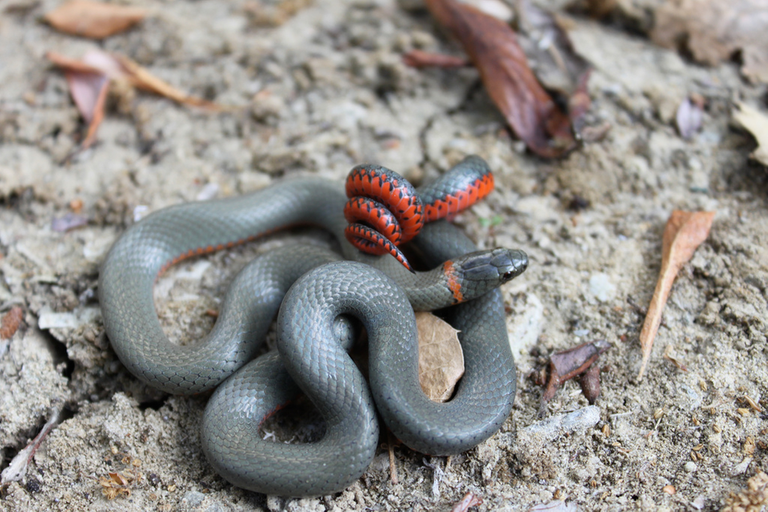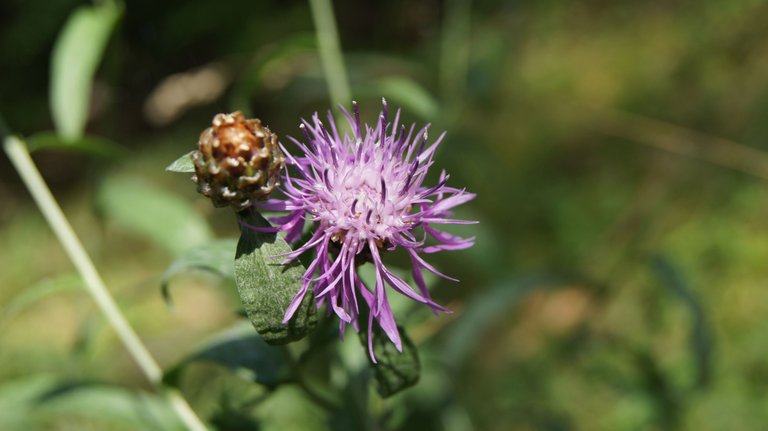It's time for the weekly nature identification thread! Post pictures of plants, animals, rocks, or other cool stuff that you've photographed but can't identify, and I, along with anyone else who would like to help, will try and help you identify it. I'll be making some changes to it- most notably, I'll be using the SBD proceeds from this post to give out @steembasicincome memberships to people who post stuff to be identified or help me identify photos.
A ringneck snake. (The one in this photo is a San Bernardino ringneck.) Ringnecks come in a variety of closely related species found across North America. While all but one species are technically venomous, the venom is fairly weak and the fangs are backward facing, so they face little threat to humans. In addition, they're exceptionally unaggressive, and largely rely on presenting their colorful underbelly (as shown here) in a defense display to protect themselves. They're nocturnal, quite reclusive, seldom grow more than six inches long, and are known to live in colonies. There were a ton of them on the farm I grew up on in Kansas. Our cats would sometimes slurp them like spaghetti. [Image source]
Remember: The most important information you can give along with any photo to be identified is its geographical location. This narrows down the range of possibilities more than any other info you can provide.
Plants:
Along with the photo, add where you found it, the time of year, the approximate altitude, and any interesting scents or textures not caught in the photo.
Animals:
Along with the photo, add the location you found it, the time of year, the sounds it made, any interesting behaviors, and any other features not caught well in the photo.
Rocks:
Along with the photo, add the location you found it, a description of the terrain it was found in, whether it was attached to a rock outcrop or found loose on the ground or buried in the soil, a description of its texture (especially its grain size), and a description of its weight and density. Fossils are included in this category. (Despite my greatest expertise lying here, rocks tend to be some of the hardest things to identify in a photo.)
Fungi:
I will not be identifying mushrooms and fungi for foraging purposes. Mushrooms should really only be identified for foraging purposes in person and by an expert. If another contributor wishes to identify them, that's their call, but I encourage them to be similarly cautious. I might also try to identify a few fungi that are clearly not being looked at for the purposes of eating, but that'll be a case by case decision.
@phoenixwren, @shasta, @snowyknight, & @artofwisdom all earned @steembasicincome memberships for submitting to the last nature identification thread or helping identify submissions. Congratulations!

Thanks so much for the SBI and this awesome thread! :)
Thanks for participating!
Hi @mountainwashere and followers. Great initiative and way to explore and learn in the world together.
Ok so here is a tree found in the dense forest of the South Island of New Zealand. I took this photo and I don't know what it is. The big tree branch that is bent (or curved) is about 1.6 m circumference. Clearly it is covered with vines, etc. I don't think I have any photos of the leaves as they were too high to get to. Any ideas?
Thanks!
Could this maybe be a Beech tree. Sure is a trippy looking
tree with what looks like root arms, perhaps a Mangrove?
I don't know many trees, but did try to look it up on goo gle
and your tree kinda looks like some of the Beeches.
What elevation was this @snowyknight ? :-)
Hey good insight. I don't think it is a mangrove as I was up in the hills (sorry I did not mention that before). Agreed that it looks like a beech some.
This was fairly low. Maybe 200 m above sea level.
remember the plant i've posted last week that we couldn't figure out? well - @roxy-cat did! It's Hyoscyamus niger.
Woohoo @artofwisdom you found out what this is!
Thanks to @roxy-cat! 👍
More than happy to help. 🙂
Hyoscyamus niger
Hyoscyamus niger, commonly known as henbane, black henbane or stinking nightshade, is a poisonous plant in the family Solanaceae.
now you're saying lol
@artofwisdom is really smart! Hence your name being correct!! Nice identification!
Thanks for holding these! I've always wondered what this plant was called (Seattle area a couple weeks ago)
it's a fern, perhaps Polystichum munitum - Western Sword Fern.
Oh cool, thanks for the id! Wow that picture looks so similar, and the name is sweet too, so I should be able to remember it
Polystichum munitum
Polystichum munitum, the western swordfern, is an evergreen fern native to western North America, where it is one of the most abundant ferns. It occurs along the Pacific coast from southeastern Alaska to southern California, and also inland east to southeastern British Columbia, northern Idaho and western Montana, with disjunctive populations in northern British Columbia, Canada; the Black Hills in South Dakota, United States; and Guadalupe Island off of Baja California, Mexico.
Forest, Northern Poland, week ago.

https://pfaf.org/User/Plant.aspx?LatinName=Centaurea+cyanus